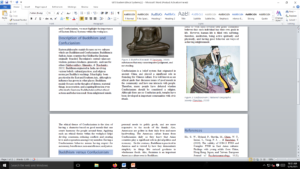Eastern Ethical systems
-
Competency
This competency will allow you to demonstrate your understanding of notable Eastern ethical systems through explanation and description.
Instructions
Often, when one thinks of ethical perspectives in the workplace, the focus tends to be on theories such as utilitarianism and egoism. While there is certainly a place for these two theories in the workplace, there remains a whole world of different perspectives and systems. For this deliverable, you will be creating a pamphlet that highlights Eastern Ethical Systems and their benefits within the workplace. Your pamphlet will need to address the following topics:
- A description of Buddhism and Confucianism.
- Key ethical themes that run through each of these traditions.
- Describe similarities and differences between the two traditions.
- Relate themes of Buddhism and Confucianism common themes within American culture.
- Describe features of the ethical perspectives of Buddhist and Confucian traditions that would be beneficial within a workplace/community.
The pamphlet that you are creating will vary in length. Draw attention to your pamphlet by using well-placed art, an easy to read design with your content, and effective use of color.
Looking for information on how to create a pamphlet? Check out
Answer preview
The two traditions are one of the major religions in China, which have had a significant impact on the culture of the Chinese. Confucianism and Buddhism both have teachings that aim at reaching ultimate harmony and helping everyone to live ethically (Tceluiko, 2019). Both encourage their followers to learn from one another by questioning what they are taught. The two religions allow their followers to practice other religions so that they may discover the truth by themselves without trusting what is told to be true.
The difference between the two is that Buddhism’s main goal is for the society to attain enlightenment and detach themselves from the cycle of rebirth and death, thus attaining Nirvana. On the contrary, Confucianism’s primary goal is for people to have a structured society. Another key difference is that in Buddhism teachings, the only way for people to escape suffering is by practicing the Eightfold path (Tceluiko, 2019). On the contrary, Confucianism stresses creating brotherhood in humanity and helping one another.
[1109 Words]

Eastern Ethical systems

